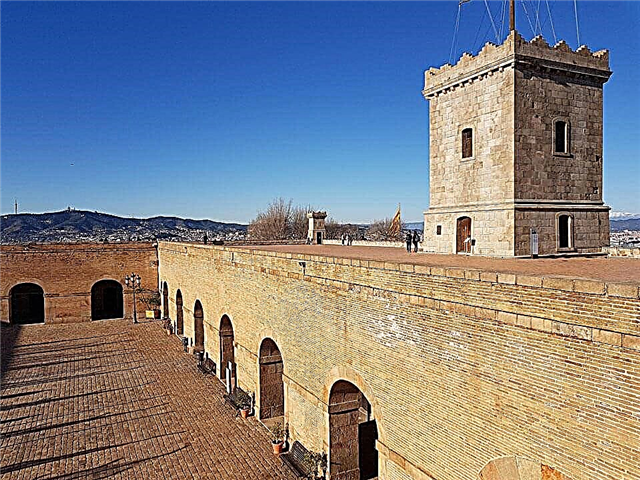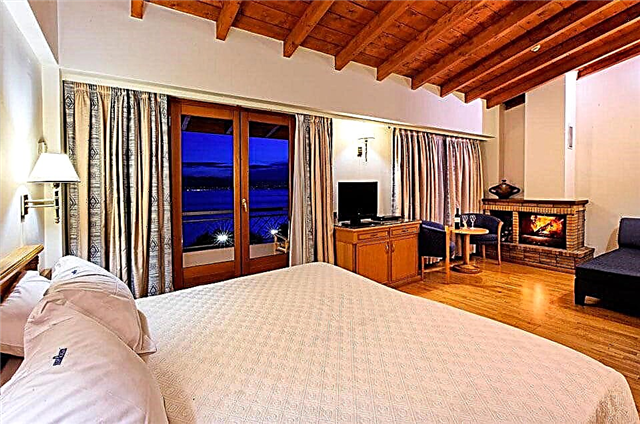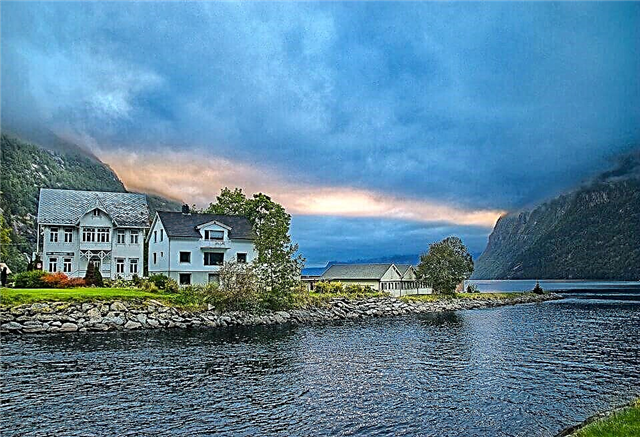Address: Russia, Yaroslavl region, Yaroslavl, Epiphany square
Foundation date: late 12th century
Main attractions: Cathedral of the Transfiguration of the Savior, the Church of Yaroslavl Wonderworkers Fedor, David and Constantine, the Church of the Resurrection of Christ (cross), the Holy Gate with the Church of the Entry into the Church of the Most Holy Theotokos, the belfry with the Church of the Pechersk Icon of the Mother of God, the Chapel of Tryphon, the Bishop of Rostov
Coordinates: 57 ° 37'18.3 "N 39 ° 53'20.3" E
Cultural heritage site of the Russian Federation
Content:
Monasteries of Yaroslavl
In the XII century, near the river crossing. Korotosl founded an Orthodox monastery, which became a fortress that defended Yaroslavl from the western side. For several centuries it played the role of a religious, economic and even political center in the life of the city. Now the monastery houses the oldest Yaroslavl church - the Transfiguration Cathedral, where wall paintings made during the time of Ivan the Terrible have been preserved.

Bird's eye view of the monastery
History of the Transfiguration Monastery from the 12th to the 17th century
The exact date of the foundation of the monastery is not known. But it is believed that this happened at the end of the 12th century. The monastery walls became part of a well-planned defensive line around Yaroslavl, protecting its western borders. It was hardly the most fortified part of the city, since the Yaroslavl Kremlin was never surrounded by its own stone walls.
The new monastery grew and developed rapidly. At the very beginning of the 13th century, a religious school was opened in it, where Orthodox clergymen were trained - the Grigorievsky vestibule. It was the first religious educational institution in North-Western Russia. After a while, he was transferred closer to the metropolitan - to Rostov.

From left to right: Church of the Yaroslavl Miracle Workers, belfry
Almost immediately, the monastery began to collect a library and were engaged in the correspondence of books. In honor of an important event - the creation of the Yaroslavl principality, in the monastery during the reign of Vasily III, the Transfiguration Cathedral was erected from stone.
The monastery enjoyed the favor not only of Yaroslavl, but also of Moscow princes. Ioann the Terrible liked to be here. Each time, arriving in Yaroslavl, the tsar left the monastery with letters of gratitude. The monastic possessions expanded and wealth grew. The monastery turned into a major feudal lord and owned 6 villages and 239 villages. She owned fishing grounds and profitable salt brews. In addition, the monastery was freed from the monetary and economic obligations adopted in Yaroslavl, had judicial immunity, and representatives of the ruling elite of the Yaroslavl lands have long been buried on its territory.

From left to right: Belfry, Church of the Yaroslavl Miracle Workers, Transfiguration Cathedral
He received such privileges from the sovereign because here the wife of Ivan the Terrible was cured of a serious illness. Fyodor, the son of John IV, also provided constant support to the monastery.
When the difficult times for Russia came, Yaroslavl was ravaged by the Polish-Lithuanian troops. Only the Spaso-Preobrazhenskaya monastery, which withstood a month-long siege, managed not to submit. And the enemy units had to leave with nothing. It is noteworthy that it was from the walls of this monastery that the second zemstvo militia headed by K. Minin and D. Pozharsky went to Moscow, which saved Russia from invasion. And in the spring of 1613, Mikhail Romanov visited the monastery, who signed a letter here, where he indicated his consent to the throne. Later, the first sovereign from the Romanov dynasty also sent rich gifts to the monastery.
After the Time of Troubles, the monastery was significantly strengthened. The perimeter of its powerful three-meter walls exceeded 800 m, and their height reached ten and a half. For defense, squeaks, carbines and barrels of gunpowder were placed on stone walls and towers. In Yaroslavl, along the road leading to Uglich, several settlements belonging to the monastery grew. The economic and political influence of the monastery at that time was not inferior to the Yaroslavl Posad.

Holy Gate with the Church of the Entry into the Temple of the Most Holy Theotokos
History of the Transfiguration Monastery in the 18th-20th centuries
In the middle of the 18th century, by the decision of the Rostov Metropolitan Arseny (Matseevich), classes began in the monastery in the spiritual Slavic-Latin seminary - one of the first Russian seminaries. Three decades later, about three hundred students studied there. This seminary was housed in the monastery until 1875.
In 1787, according to the decision of the Russian Empress Catherine II, the chair of the Rostov Metropolitan moved to Yaroslavl, and the monastery was transformed into a bishop's house. Several years later, in the 90s of the 18th century, among a large library, where a lot of old books and manuscripts were kept, A.I.Musin-Pushkin made an outstanding discovery in the history of Russian literature. In the monastery chamber, among the ancient manuscripts, he discovered a unique manuscript "The Lay of Igor's Host", dated to the 12th century. This historical find, and in particular the publication of the text of the Lay ... brought the Russian historiographer and collector fame throughout the world.
In the 19th century, several new stone buildings appeared on the territory of the former monastery - a building for seminarians, the Smolensk chapel and a temple dedicated to the Yaroslavl Miracle Workers. In addition, the restoration of the Holy Gates and monastery walls took place at this time.

Church of the Resurrection of Christ (cross)
During the years of Soviet power, various institutions and departments were located in the monastery buildings - a military registration and enlistment office, a prison, a kerosene shop and educational institutions. In the XX century, this architectural complex was restored twice. In 1918, the walls and churches were damaged as a result of the White Guard uprising in Yaroslavl. The consequences of the destruction were liquidated within five years - until 1923. The second restoration took place in the monastery in 1957-1958. After her, the territory of the former monastery was given to the city historical, architectural and art museum-reserve, which is located here to this day.
Architectural monuments on the territory of the Transfiguration Monastery
The main architectural monument of the monastery is considered to be the Transfiguration Cathedral. The very first cathedral made of stone was erected in a male monastery back in 1216-1224. With this construction, the Yaroslavl people marked the formation of their principality. However, at the very beginning of the 16th century, there was a big fire, the temple was badly damaged, and it had to be rebuilt. A beautiful temple, similar to the main Kremlin cathedrals in Moscow, was consecrated in 1516. It is believed that this structure laid the foundations of the traditions of the Yaroslavl architectural school.

Chapel of Tryphon
Half a century later, the cathedral was painted with frescoes. Fortunately, they are partially preserved and today they are the oldest frescoes in Yaroslavl. Wall paintings from the time of Ivan the Terrible have survived only in two churches in Russia. In addition to Yaroslavl, similar frescoes can be seen in the Bogoroditsko-Uspensky monastery, which is located in the city of Sviyazhsk in Tatarstan. In the Spaso-Preobrazhensky Cathedral, 16 icons, painted for the temple iconostasis by Moscow and Yaroslavl iconographers, have also miraculously survived.
The architectural appearance of the cathedral has changed a lot over several centuries. Only the eastern (altar) part of the facade with characteristic semicircular apses has its original appearance. The three-domed temple is crowned with low helmet-shaped domes.
In the 60s of the 16th century, the first tower made of stone was erected on the monastery wall - the beautiful Holy Gate. At the same time, the wooden walls were replaced with stone ones and the Refectory Chamber and the Church of the Nativity of Christ (or the Cross Church) were built.Later, at the beginning of the 19th century, this temple was rededicated into the Resurrection.

Epiphany tower
During the years when the monastery was rebuilt and rebuilt after the Polish-Lithuanian intervention, several stone towers were erected, from which we can see the Uglich and the Mother of God today. Two other towers - Mikhailovskaya and Epiphany - were built in the monastery at the very beginning of the 19th century.
At the end of the 17th century, a cell building was erected in the monastery. Now this two-story building houses museum collections, where you can see precious royal contributions and treasures from Orthodox churches in the Yaroslavl region.
Side by side with the Transfiguration Cathedral is the Yaroslavl Miracle Workers Church, built in the 30s of the XIX century. It is recognizable from afar by the portico with white columns. This church was laid on the foundation of an older temple - the Church of the Entry into Jerusalem, which existed here since the beginning of the 17th century.
The belfry is the tallest building on the monastery grounds. This bell tower was built in the 16th century. and was additionally built on in the 19th century. Its high observation deck offers wonderful views of the Korotosl estuary, the Volga and the city itself.

Mikhailovskaya tower
Several years ago, a memorial stele "Oath of Prince Pozharsky", decorative bee hives made in the form of architectural monuments - a temple, a tower and a wooden hut, as well as a monument "Kopeyka of 1612" were erected on the territory of the monastery.
Current state and regime of visiting the Spaso-Preobrazhensky Monastery
Today, the main collections of the Yaroslavl Museum-Reserve are located within the walls of the ancient monastery. In this cultural center of the city, Yaroslavl icons painted from the 16th to the 19th centuries are exhibited, as well as unique art products made of precious metals. There are also expositions in the museum telling about the nature of the Yaroslavl region, about the "Lay of Igor's Host" and the history of the monastery. And for groups of adult visitors and high school students, there are several interactive programs and master classes on an etching machine. Entrance to the territory and visits to museum expositions are paid.

Uglich tower, view from the territory of the monastery
From October to April, the territory is open to visitors every day from 9.00 to 18.00 (ticket offices close half an hour earlier). Museum expositions are open from 10.00 to 17.30 (ticket offices close an hour earlier). From May to September, the territory is open daily from 8.00 to 20.00 (ticket offices close an hour earlier). Museum expositions are open from 10.00 to 17.45 (ticket offices are open until 17.00). The day off is Monday.
You can get to the Transfiguration Cathedral during the warm season - from May to September from 10.00 to 18.00. It is closed on Wednesdays and, on the recommendation of restorers, on rainy days.
How to get to the Spaso-Preobrazhensky monastery
The monastery is located at the address: Epiphany Square, 25, in the Kirovsky district of the city, next to the Moscow bridge over the Korotosl, not far from its mouth.
By car. The federal highway M8 leads from Moscow to Yaroslavl. Within the city limits, it is called Moskovsky Prospekt. The territory of the monastery is located on the right, just behind the road bridge over the Korotosl River.

Transfiguration Cathedral
By train. From Moscow to Yaroslavl, express train trains reach in 3 hours 16 minutes. The journey by regular train takes from 4 to 5.5 hours. From the Moskovsky railway station in Yaroslavl, the distance to the Transfiguration Monastery is 2.5 km. They can be walked or taken by minibus.











